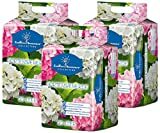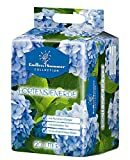Yellow leaves on hydrangeas indicate a nutrient deficiency. Iron deficiency is particularly common in ericaceous plants such as hydrangeas. We show you how to recognize and successfully remedy what is known as iron deficiency chlorosis.

When the leaves of your hydrangea (Hydrangea) turn yellow due to a lack of chlorophyll, i.e. a so-called chlorosis occurs, the cause may be an iron deficiency. Although the lack of other nutrients can also cause chlorosis, these differ visually from the typical iron deficiency chlorosis.
Iron is an essential part of the chlorophyll synthesis pathway, so a lack of iron means that no new chlorophyll can be produced. However, the green pigment is a central component of photosynthesis and therefore essential for the survival of every plant. The cause of the "chlorosis" should therefore be eliminated quickly. Here's how to tell if a hydrangea's chlorotic leaves are actually caused by iron deficiency. In addition to information on how to successfully correct iron deficiency, you will also find tips on how to prevent chlorosis on hydrangeas.
Tip: Iron deficiency is particularly common in hydrangeas and in general in all bog plants that love acidic and organic soil.
contents
- Recognizing iron deficiency chlorosis in hydrangeas
- Preventing iron deficiency chlorosis on hydrangeas
- Successfully remedying iron deficiency chlorosis in hydrangeas
Recognizing iron deficiency chlorosis in hydrangeas
With a hydrangea, the symptoms usually always look the same. It doesn't matter whether the plant is in a bucket or in a bed. The young leaves turn yellow first, with the thick leaf veins initially remaining green. Because it then looks like a branched coniferous tree, this damage is also called the "Christmas tree effect".
Here's how to distinguish iron deficiencies from similar nutrient deficiency symptoms:
- Nitrogen deficiency starts on the oldest leaves and causes completely yellow leaves with no green leaf veins.
- The same applies to sulfur deficiency, but this occurs very rarely.
- Magnesium deficiency also shows up first on the older leaves, but the leaf veins remain green.

Preventing iron deficiency chlorosis on hydrangeas
The missing nutrient in hydrangeas is often iron, even if there is almost always enough of it in the natural soil. The reason for the deficiency is therefore not a lack of iron in the substrate, but that the hydrangea cannot absorb the iron that is present. This occurs in hydrangeas when the soil pH is too high. The bog plant is adapted to low soil pH values of around 4 - 5.5. Unlike other plants, the hydrangea is dependent on iron as a directly available, 2-valent form (Fe 2+) in the soil solution. However, divalent iron occurs almost exclusively in acidic soils in which iron has been oxidized to this stage - and the hydrangea is adapted to precisely these substrates. A so-called "relative iron deficiency" inevitably develops on calcareous soils: Iron is present but cannot be absorbed by the plant.

Tip: It is also interesting that the different colors of the hydrangea blossoms also depend on the pH value. For example, the blue hydrangea needs a pH of 4 - 4.5 to be able to absorb enough aluminum for the blue flower. More information about Dyeing hydrangeas blue find out in this special article.
We at Plantura recommend the following products for hydrangeas:- Floragard Endless Summer hydrangea soil pink & white: Special soil for healthy and strong hydrangeas. The clay granules improve air and water circulation.
- Floragard Endless Summer hydrangea soil blue: Special soil for healthy and strong hydrangeas. Aluminum fertilizer keeps the strong, bright blue blooms in the long term. The clay granules improve air and water circulation.
- Floragard compost soil: Special soil made from weed-free premium compost and selected peat qualities. It supplies your plants with all the important nutrients over a long period of time and evenly, and the high humus content makes light and heavy soil fertile.

Floragard Endless Summer hydrangea soil pink/white 3x20 L • for planting and...
25,99€
Details →

Floragard Endless Summer hydrangea soil blue 20 L
7,99€
Details →

Floragard compost soil 60 L
9,99€
Details →
The best way to prevent iron deficiency chlorosis in hydrangeas is to plant them in suitable, acidic soil. When planting in the bed, peat or peat-reduced acidic soil is mixed in and the pH value is preferably checked annually. Because the soil around the mixed substrate influences the pH value of the potting soil in the long run in such a way that the pH value increases again.
In order for the pH value to be determined correctly, a pH test is required, which is available from various providers. If the measured pH value is too high, this can be corrected with our Plantura organic acidic soil, lime-free peat or grape pomace. Potted hydrangeas should be planted in acidic soil right away.

Successfully remedying iron deficiency chlorosis in hydrangeas
The first step in correcting iron deficiency chlorosis is to control and adjust the pH level. In very rare cases, however, there is also an "absolute" iron deficiency: iron is simply not available. This happens more often with tub culture than with bedding plants, because the purely organic substrate only contains a limited supply of iron. If the pH value of the substrate is low and the hydrangea still shows the iron deficiency symptoms described above, then iron must be fertilized. This can be done either with granular fertilizer, liquid fertilizer or foliar fertilization:
- Granulated fertilizer with iron: A special fertilizer granulate is well suited to remedying and preventing iron deficiency. Our Plantura organic hydrangea fertilizer contains, for example, a sufficient amount of iron to rule out an absolute iron deficiency from the outset. By slightly acidifying the soil with iron sulphate, a relative iron deficiency is also prevented. It is also based on animal-free raw materials from the food, luxury goods and animal feed industries, as well as mineral components that are also used in organic farming. Thus is ours Plantura organic hydrangea fertilizer truly "organic" and ideal for sustainable gardening. The granules have a long-term effect.
- Liquid fertilizer with iron: A liquid fertilizer that contains iron with so-called chelating agents is more effective than the granular fertilizer. Chelates are produced by plants at the roots to convert iron into a usable form. Unfortunately, hydrangeas cannot do this. Special fertilizers like ours Plantura Organic Citrus & Mediterranean Fertilizer contain iron, other trace elements and suitable chelating agents to remedy deficiencies in the shortest possible time.
- Iron Foliar Fertilization: To a limited extent, plants can also absorb nutrients through the leaf. In this way, the trace element gets directly into the plant organ where it is needed. However, iron foliar fertilization is usually superfluous for private users. It is only used by professional companies where a prolonged iron deficiency would mean severe yield losses. The necessary special fertilizers are also often expensive and require a precisely dosed application in order not to cause leaf damage. Foliar fertilization only has a short-term effect and must be used frequently or supplemented by normal iron fertilization.

More information on the topic Fertilize hydrangeas can be found in the corresponding special article.



